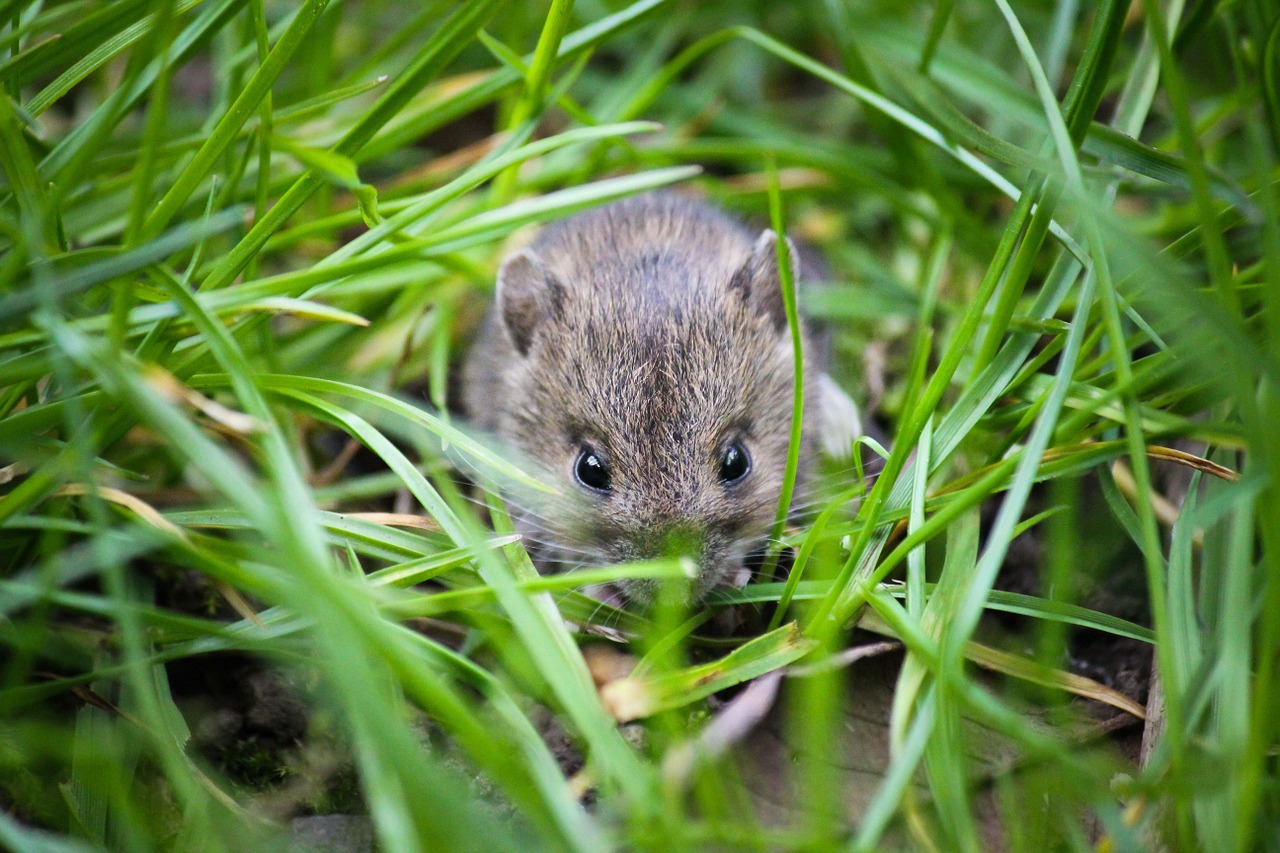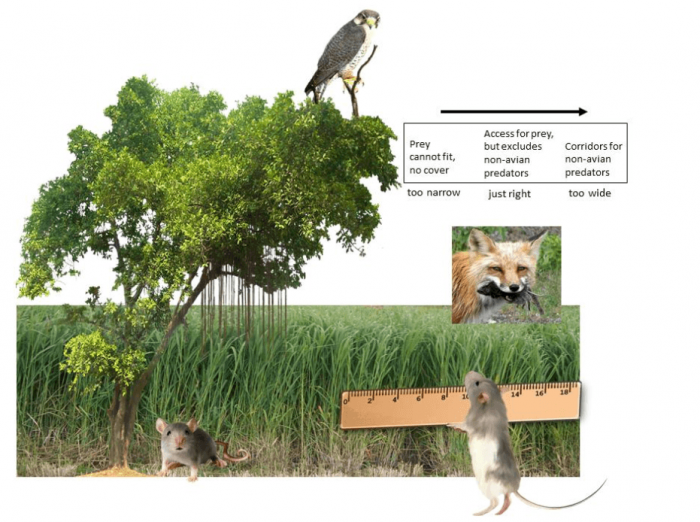
As a renewable replacement for fossil fuels, biofuels promise to reduce the negative impacts of climate change on biodiversity. However, concerns have been raised about the effects of displacing less-managed lands to grow bioenergy crops.
In a recent review article, Jager and Kreig (2018) synthesized guidelines for coproducing biomass and wildlife for production systems along a latitudinal gradient from North to South America. In the review, the authors considered whether land-sharing or land-sparing strategies work better to promote coproduction. Land sharing involves interspersion of wildlife-friendly habitat features throughout. Land sparing is a strategy of setting aside large areas as wildlife reserves with no biomass production. Theory suggests that land sharing is more effective when lands in production are managed at a low intensity and that sparing is more effective when production intensity is high.
Higher biodiversity tends to be found in tropical areas. In tropical biodiversity hotspots, it is especially important to adopt a land-sparing strategy, i.e., to manage lands by creating large conservation reserves. Such hotspots may still support wide-ranging top predators that require large areas of good habitat. In addition, biomass production should occur in small areas when production intensity is high. If a wildlife species has poor gap-crossing behavior, then it is very important to provide safe corridors that connect patches of wildland habitat. For example, one study in the Amazon basin found that arboreal primates and sloths were unable to cross oil-palm plantations where there were breaks in the canopy (Mendes-Oliveira et al. 2017). A “sparing” design that protects a large area of intact rainforest nearby may, therefore, be beneficial.
At the scale of one landholder, wildlife-friendly elements and practices can be included in the landscape. Zoning for wildlife should consider the traits of species that are highly valued or rare. Other species avoid travel through open areas; they require understory to provide cover from predators. This can be addressed through a “land-sharing” design by including wildlife-friendly elements (i.e., pruning the overstory and allowing an understory to grow).
One interesting design question at a finer resolution is whether there is an optimal plant spacing. Spacing can be an important design parameter both when growing perennial bunch grasses for biofuels and in plantations growing short-rotation woody crops. When planted too close together, grass yields per unit land area are high, but small mammals and birds are unable to travel between plants (Figure 1). When spaced too far apart, wildlife are exposed to avian and other predators (Figure 1). On the other hand, pollinator species may benefit from wider spacing (or spacing during establishment) because nectar-producing forbs (weeds) can grow where light hits the ground. This has been observed for miscanthus. The cartoon figure below illustrates the need for a ‘Goldilocks’ solution – spacing that is wide enough to permit movement but narrow enough to exclude predators.

Figure 1. Cartoon illustration of a mouse measuring the spacing between perennial grass plants to see whether it is too close (not enough space to travel) or too far (exposed to predators). Figure courtesy Henriette Jager.
In the case of plantations, production is highest when trees are planted far enough to avoid competition and when understory vegetation is controlled. Allowing an understory to grow creates habitat for ground-dwelling species that require cover. One option is to stagger harvests to allow plant regeneration in some areas of the landscape, producing an overall land-sharing mosaic of vegetation of different heights (Fargione et al. 2009). This leads to a more general principle, to promote wildlife diversity by including structural and vegetative diversity. Key structural elements promote species coexistence by providing refuge for smaller prey species, resulting in a more diverse community of species.
Wildlife-friendly options that promoting beneficial insects result in biocontrol of pests, pollination services, and prey for higher trophic levels. Options include avoiding pesticide use and providing groundcover, such as leaf litter or understory vegetation to support arthropods and other beneficial insects. To achieve this goal, sufficient residues from crops and forest should be left when harvesting biomass for cellulosic-ethanol production. For pollinators, allowing forbs to grow in field margins is beneficial to wildlife.
Spatiotemporal harvest strategies can be optimized to minimize trade-offs between benefits to wildlife and to biomass-crop production. Thus, land-sharing can consist of time-sharing, whereby habitat is maintained for wildlife during a critical time period or, for example, biomass harvest is staggered to leave some areas for wildlife foraging, nesting, and cover.
A final recommendation by Jager and Kreig (2018) is to implement practices that minimize wildlife damage to crops. Designing wildlife-friendly biomass production systems should start by understanding landholder’s concerns. For example, although understory provides habitat for wildlife, plantation owners in Central and South America prefer to keep understory cleared, in part, to avoid dangers associated with poisonous snakes and other wildlife that pose real threats to workers. In the case of allowing forbs to grow in field margins (for biocontrol and pollinators), opposition centers on concerns about these areas being a source of weeds. It is important to understand why landholders oppose wildlife-friendly measures so that management plans can take them into account. Otherwise, they are unlikely to be adopted.
These guidelines, derived from research in production systems spanning the Americas, suggest that design and zoning of lands that support biomass production systems can help to promote coexistence between valued wildlife and biomass for energy.
This manuscript has been authored by UT-Battelle, LLC under Contract No. DE-AC05-00OR22725 with the U.S. Department of Energy. The United States Government retains and the publisher, by accepting the article for publication, acknowledges that the United States Government retains a non-exclusive, paid-up, irrevocable, world-wide license to publish or reproduce the published form of this manuscript, or allow others to do so, for United States Government purposes. The Department of Energy will provide public access to these results of federally sponsored research in accordance with the DOE Public Access Plan (http://energy.gov/downloads/doe-public-access-plan).
These findings are described in the article entitled Designing landscapes for biomass production and wildlife, recently published in the journal Global Ecology and Conservation.
References:
- Fargione, J.E., T.R. Cooper, D.J. Flaspohler, J. Hill, C. Lehman, T. McCoy, S. McLeod, E.J. Nelson, K.S. Oberhauser, D. Tilman. 2009. Bioenergy and wildlife: threats and opportunities for grassland conservation Bioscience, 59: 767-777.
- Jager, H.I. and J.A.F. Kreig. 2018. Designing landscapes for biomass production and wildlife. Global Ecology & Conservation 16, e00490.
- Mendes-Oliveira, A.C., C.A. Peres, P. Maues, G.L. Oliveira, I.G.B. Mineiro, S.L.S. de Maria, and R.C.S. Lima. 2017. Oil palm monoculture induces drastic erosion of an Amazonian forest mammal fauna. PloS One, 12.









